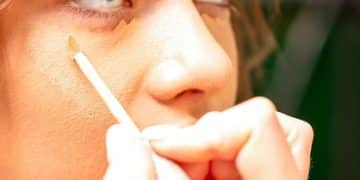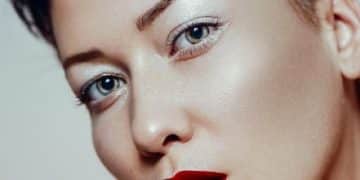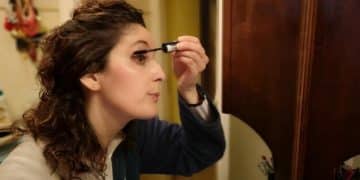Cover Dark Circles Like a Pro: Tips & Product Recommendations
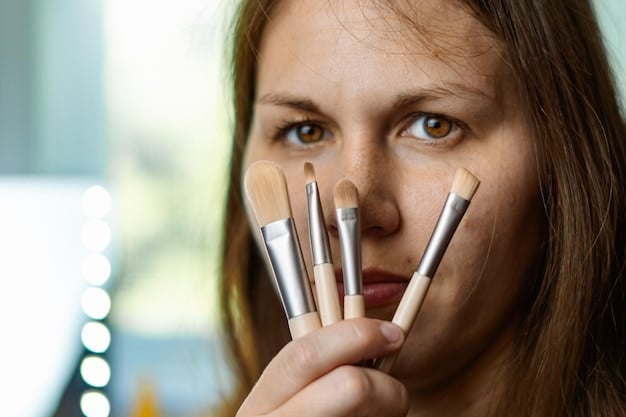
Covering dark circles effectively involves understanding their causes, using the right concealing techniques, and selecting products that not only camouflage but also address the underlying issues, ensuring a flawless and natural look.
Do you struggle with stubborn under-eye circles that no amount of sleep seems to fix? You’re not alone. Learning how to cover dark circles like a pro: insider tips and product recommendations is a game-changer for achieving a refreshed and radiant complexion.
Understanding Dark Circles: Causes and Types
Before diving into concealing techniques, it’s essential to understand what causes dark circles. They aren’t always just about lack of sleep; several factors influence their appearance and the best way to address them.
Knowing the root cause of your dark circles will help you choose the most effective concealing method and skincare routine to minimize their appearance over time.
Common Causes of Dark Circles
Several factors contribute to the formation of dark circles. Here are some of the most prevalent:
- Genetics: Your family history can predispose you to having thinner skin under the eyes, making blood vessels more visible.
- Lack of Sleep: Insufficient sleep can cause blood vessels to dilate, creating a darker appearance under the eyes.
- Age: As you age, the skin loses collagen and becomes thinner, making dark circles more prominent.
- Sun Exposure: Excessive sun exposure can lead to hyperpigmentation, darkening the skin around the eyes.
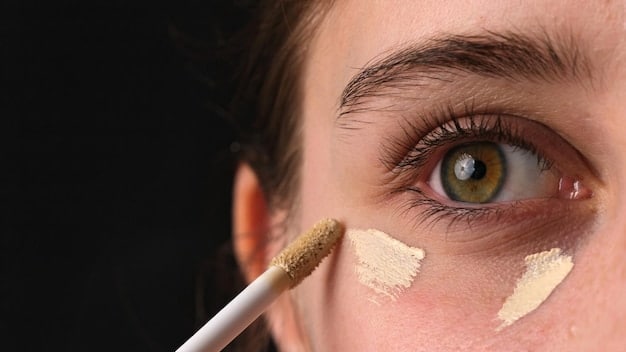
Types of Dark Circles
Dark circles aren’t all the same. Identifying the type you have can help you tailor your approach:
- Pigmented Dark Circles: These are brown in color and caused by excess melanin.
- Vascular Dark Circles: These appear blue or purple due to visible blood vessels.
- Shadows: These aren’t actually discoloration but shadows caused by under-eye bags or hollows.
- Combination: Many people experience a combination of these types.
Understanding the causes and types of your dark circles is the first step towards effective coverage. From genetics to lifestyle factors, numerous elements can contribute to their appearance. Identifying these factors allows you to select the most appropriate concealing techniques and skincare products.
Prepping the Under-Eye Area: Skincare Essentials
Before you even think about concealer, proper skincare is crucial. A well-hydrated and nourished under-eye area will make concealer application smoother and prevent a cakey finish.
This includes gentle cleansing, moisturizing, and dedicated treatments to address the specific needs of this delicate skin.
Gentle Cleansing
The skin around your eyes is the thinnest on your face, so it requires a delicate touch. Use a gentle, non-irritating cleanser to remove makeup and impurities.
Hydration is Key
A good moisturizer is essential. Look for products containing hyaluronic acid, which attracts and holds moisture, plumping up the skin and reducing the appearance of fine lines and dark circles.
Targeted Treatments
Consider using eye creams with ingredients like:
- Vitamin C: Brightens the skin and reduces hyperpigmentation.
- Retinol: Stimulates collagen production, improving skin thickness and reducing the visibility of blood vessels.
- Caffeine: Constricts blood vessels, reducing the appearance of vascular dark circles.
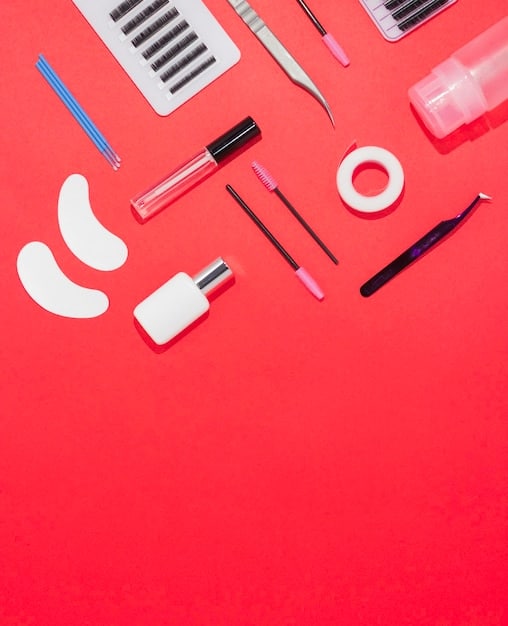
Preparing your under-eye area with the right skincare products is foundational for achieving a flawless and natural-looking concealer application. Ensuring the skin is well-hydrated, nourished, and treated with targeted ingredients can significantly improve the overall effectiveness of your concealing efforts.
Choosing the Right Concealer: Texture, Color, and Coverage
Selecting the right concealer is paramount. The texture, color, and coverage level all play a role in effectively concealing dark circles without looking heavy or unnatural.
Knowing what to look for based on your skin type and the nature of your dark circles ensures a flawless and lasting finish.
Texture Matters
The texture of your concealer can make or break your look. Creamy, hydrating formulas are generally best for the under-eye area, as they won’t settle into fine lines.
Color Correction
Color correcting concealers can neutralize discoloration before you apply your regular concealer. Here’s a quick guide:
- Peach or Orange: Corrects blue or purple dark circles in medium to dark skin tones.
- Pink or Salmon: Corrects blue or purple dark circles in fair to light skin tones.
- Yellow: Corrects mild redness or dullness.
Coverage Level
Consider the level of coverage you need. If your dark circles are mild, a light to medium coverage concealer may suffice. For more severe discoloration, opt for a full coverage formula.
Choosing the right concealer involves understanding its texture, the necessity of color correction, and the appropriate level of coverage. Creamy, hydrating formulas work best for avoiding creasing, while color-correcting concealers neutralize discoloration. Selecting the right concealer guarantees a seamless and radiant look.
Application Techniques: Mastering the Blend
The way you apply your concealer is just as important as the product itself. Proper technique ensures even coverage and prevents creasing or a cakey appearance.
Focus on layering thin amounts of product and blending seamlessly into the surrounding skin for a natural finish.
Start with a Primer
Applying an eye primer creates a smooth canvas for your concealer. It helps fill in fine lines and prevents the concealer from settling.
Use a Light Hand
Apply your concealer in thin layers. It’s easier to build coverage than to remove excess product.
Blending is Key
Use a damp makeup sponge or a concealer brush to blend the product seamlessly into your skin. Gently pat or stipple the concealer, avoiding harsh rubbing.
Setting the Concealer
To prevent creasing, set your concealer with a light dusting of translucent powder. Use a small, fluffy brush to apply the powder sparingly.
Mastering the application of concealer includes starting with an eye primer, applying thin layers of product, and blending seamlessly with a damp sponge or brush. Setting the concealer with a light dusting of translucent powder prevents creasing and ensures a long-lasting, impeccable finish.
Product Recommendations: Concealers and Tools
With so many products on the market, it can be overwhelming to choose the right ones. Here are some top-rated concealers and tools to help you cover dark circles like a pro.
These recommendations span a range of textures, coverages, and price points, ensuring there’s something for every skin type and concern.
Top Concealers
- NARS Radiant Creamy Concealer: A cult favorite for its creamy texture and medium, buildable coverage.
- Tarte Shape Tape Concealer: Known for its full coverage and long-lasting formula.
- IT Cosmetics Bye Bye Under Eye Concealer: A highly pigmented, waterproof concealer that provides full coverage.
Essential Tools
- Beautyblender: A makeup sponge that provides a seamless, airbrushed finish.
- Real Techniques Setting Brush: A small, fluffy brush perfect for applying setting powder under the eyes.
Selecting the right products and tools can significantly enhance your concealer application. Popular concealers include NARS Radiant Creamy Concealer for its creamy texture, Tarte Shape Tape Concealer for its full coverage, and IT Cosmetics Bye Bye Under Eye Concealer for its highly pigmented, waterproof formula. Essential tools like the Beautyblender and Real Techniques Setting Brush ensure a flawless application and long-lasting results.
Lifestyle Adjustments: Long-Term Solutions
While concealer is a quick fix, addressing the underlying causes of dark circles can provide long-term improvements.
Making lifestyle adjustments can significantly reduce the prominence of dark circles, enhancing the effectiveness of your concealing efforts and promoting overall skin health.
Prioritize Sleep
Aim for 7-8 hours of quality sleep each night to reduce blood vessel dilation and improve overall skin health.
Stay Hydrated
Drinking plenty of water keeps your skin hydrated, reducing the appearance of dark circles and fine lines.
Protect from the Sun
Wear sunglasses and apply sunscreen to protect the delicate skin around your eyes from hyperpigmentation.
Healthy Diet
Eat a balanced diet rich in vitamins and antioxidants to support skin health.
Addressing the underlying causes of dark circles through lifestyle adjustments provides long-term improvements and enhances the effectiveness of concealer. Prioritizing sleep, staying hydrated, protecting from the sun, and maintaining a healthy diet can significantly reduce the prominence of dark circles.
| Key Point | Brief Description |
|---|---|
| 😴 Prioritize Sleep | 7-8 hours of quality sleep can reduce dark circles. |
| 💧 Stay Hydrated | Drinking water improves skin hydration and reduces dark circles. |
| 😎 Sun Protection | Use sunscreen and sunglasses to prevent hyperpigmentation. |
| 🧴 Right Concealer | Choose creamy, hydrating formulas with color correction if needed. |
Frequently Asked Questions
▼
Yes, lack of sleep can cause blood vessels under the eyes to dilate, creating a darker appearance. Aim for 7-8 hours of quality sleep to improve skin health and reduce dark circles.
▼
Creamy, hydrating concealers are generally best for the under-eye area. They prevent creasing and provide a smoother finish. Color-correcting concealers can also help neutralize discoloration.
▼
To prevent creasing, start with an eye primer, apply thin layers of concealer, blend well, and set with a light dusting of translucent powder. Hydrating the under-eye area is also key.
▼
Yes, ingredients like vitamin C, retinol, and caffeine can help reduce dark circles. Vitamin C brightens the skin, retinol stimulates collagen production, and caffeine constricts blood vessels.
▼
Yes, excessive sun exposure can lead to hyperpigmentation, darkening the skin around the eyes. Wear sunglasses and apply sunscreen to protect this delicate area from sun damage.
Conclusion
Mastering the art of concealing dark circles involves understanding their causes, prepping the under-eye area with proper skincare, choosing the right concealer and tools, applying effective techniques, and making beneficial lifestyle adjustments. By incorporating these tips and recommendations, you can achieve a flawless and refreshed look, confidently minimizing the appearance of dark circles and enhancing your natural beauty.
